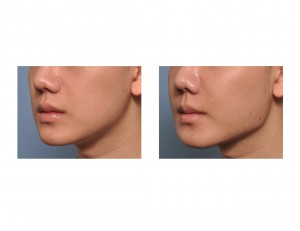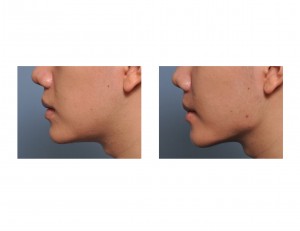Background: Enhancement of the jaw is historically perceived as a chin augmentation procedure. But the chin occupies less than 1/3 of the jawline and neglects the back part of the jaw which is much larger and makes up a significant part of the lower face. This jaw angle area is having increased recognition as being an important part of an aesthetically desireable jawline, particularly in men.
The jaw angles are uniquely different than the chin, not only in its shape, but because there are two of them. Its shape is created by the intersection of the horizontal lower border of the jaw with the posterior or vertical border of the jaw. This entire area is known as the ramus of the mandible. When the ramus is underdeveloped, it creates a high or obtuse jaw angle that is vertically short. (as judged by its position to the anterior chin) When it is developed more strongly, the ramus is vertically longer and the jaw angle is sharper and more defined. When the ramus is longer it often has a wider flare at the angle point as well.
Of all the facial implants, jaw angle implants are the least commonly done and have the fewest options of styles and shapes to use. It is also the hardest facial implant to place, being deep in the oral cavity and have to disinsert part of the masseteric muscle attachments for proper placement. To ensure implant stability, small screws are usually placed through a percutaneous approach to prevent after surgery displacement from the strong maasster muscle action.
Case Study: This 23 year-old male had a prior history of rhinoplasty and chin and cheek implant augmentation. While he was pleased with these facial improvements, he felt that his jawline was still deficient and wanted more visible and flared jaw angles for a more masculine appearance.



Case Highlights:
1) Jaw angle implants are often needed to complete a total jawline enhancement.
2) Creating a better defined jaw angle usually means that it must have vertical lengthening that creates a sharper and more visible 90 degree shape.
3) Jaw angle implants are placed from inside the mouth and under the masseter muscle.
Dr. Barry Eppley
Indianapolis, Indiana


